Family : Malvaceae

Text © Prof. Pietro Pavone

English translation by Mario Beltramini
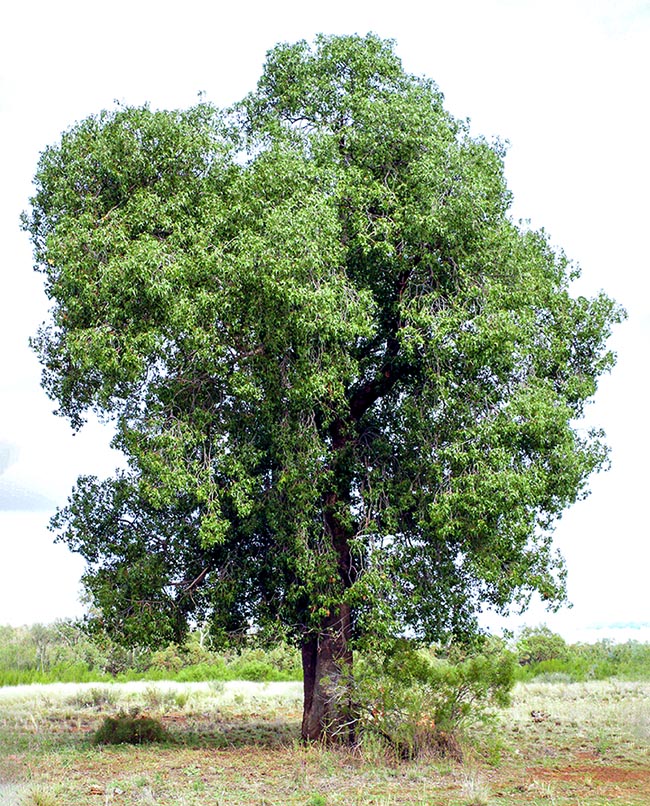
Brachychiton populneus subsp. trilobus is an evergreen of eastern Australia, usually 12 to 15 m tall, with robust trunks able to store huge quantities of water for surviving in the areas with warm and dry climate © Tony Rodd
Brachychiton populneus (Schott & Endl.) R.Br. belongs to the family of the Malvaceae, and to the subfamily Sterculioideae.
It is a species native to western Australia, whose range extends from Queensland to the eastern extremity of Victoria.
It mainly grows in the subtropical biome, on well drained soils, diffused also among rocky outcrops of granite or limestone, from the coast up to the semi-arid hinterland.
The term Brachychiton comes from the Greek “βραχύς” (brachýs), short, brief, and from “χῐτών” (chitón), tunic, due to the woody fruits inside which the seeds are wrapped by bristles forming a sort of short tunic. The name populneus comes from the genus Populus because the leaves are similar to those of the poplar.
The genus Brachychiton Schott & Endl. (1832) was, in the past, included in the genus Sterculia, but the peculiarity of the fruits (follicles), of the integuments of the seed and of the embryo has suggested the maintaining of Brachychiton as a separate genus and included, by the APG classification, in the family Malvaceae.
Brachychiton populneus, known as Kurrajong or Bottle tree, was described for the first time by Heinrich Wilhelm Schott (1794-1865) and by Stephan Feriedrich Ladislaus Endlicher (1804-1849) with the name of Poecilodermis populnea, but it was Robert Brown (1773-1858) to give it the correct binomial and presently in use in the publication “Pterocymbium 234, 1844”.
Brachychiton populneus is a species characterized by 12 to 15 (20) m tall evergreen trees, usually with robust trunks able to store great quantities of water for surviving in the areas having a warm and dry climate. The crown measures 12 to 15 m in diameter. The bark, on the young plants and on the smaller branches, is green and smooth, but gets dark, compact and coarsely cracked, on the mature trunks and branches.
The leaves are glossy green on the upper pagina and pale green on the inferior one, but vary remarkably in shape. Usually they present an entire margin and may have a lamina simple and elongated or lobed (3 to 5 lobes), 5-16 cm, with base mainly cuneate, at times truncated or cordate and usually apiculate tip.
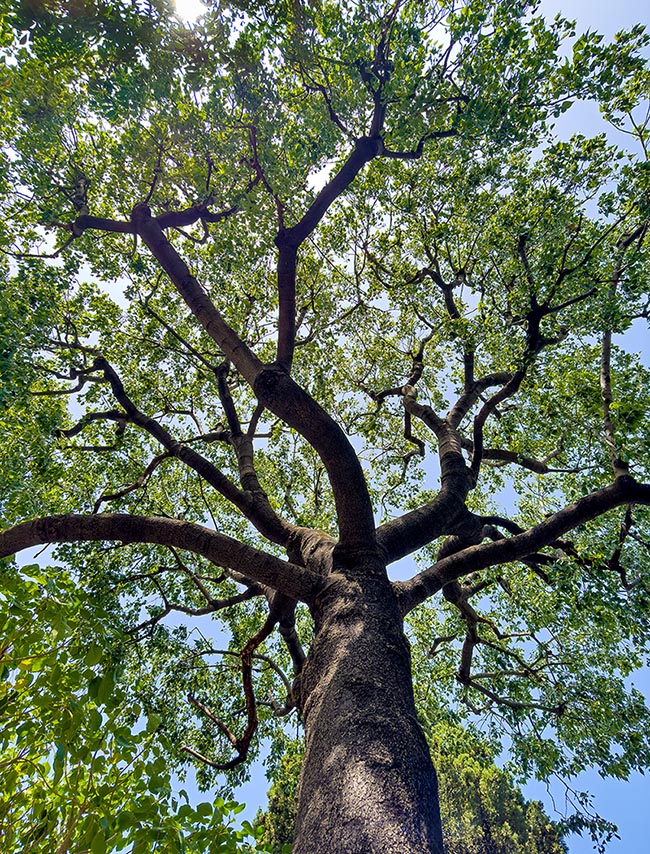
Brachychiton populneus subsp. populneus has the leaves similar to the and is very frequent in the Mediterranean gardens cultivation. It grows well where day temperatures exceed 13 °C but doesn’t tolerate frost © G. Mazza
After the shape of the leaves we distinguish two subspecies: Brachychiton populneus subsp. populneus with entire leaves like those of the poplar (Populus) and Brachychiton populneus subsp. trilobus Guymer, with leaves having 3 thin, at times 5 or more, lobes.
This subspecies is found in the inner waters of New South Wales and of Queensland.
The flowers appear from October to December in the austral hemisphere, typically bell-shaped with 5 tips curled backwards grouped in 10 to 60 flower panicles.
As it is a monoecious species, the flowers are unisexual due to the abortion of one sex.
The male ones have an extension of the column-shaped (androphore) receptacle bearing the stamens, 3,5-4,5 mm long, glabrous and white in the upper part and reddish and pubescent in the lower.
The female flowers have a short extension of the receptacle bearing the gynoecium (gynophore), 0,6-0,8 mm long, glabrous, of cream or pale green colour above and reddish below.
The stamens are 20. The ovary, surrounded by staminodes, is pubescent, the styles are usually glabrous and the stigmata are connate at the base.
The flowers measure 10-16 x 13-16 mm, without petals, with the sepals of pale colour outside varying from white or white-greenish to cream to pale pink, and inside dotted with red, rarely red or violaceous.
The fruits are coriaceous follicles, ellipsoid to ovoid, navicular at dehiscence, present on the branches for a long time.
In the subsp. populneus the follicles are 4-7 cm long on 2-3,5 cm stems and contain 8-18 seeds; in the subsp. trilobus they are 2-4 cm long on 2-5 cm stems, usually with 3-8 seeds. The seeds, wrapped by brown-yellowish stinging hairs, resemble corn kernels. The chromosomal number is 2n = 40.
Brachychiton populneus has many uses. In the past the bark was utilized by the Australian natives as twine and fishing lines.
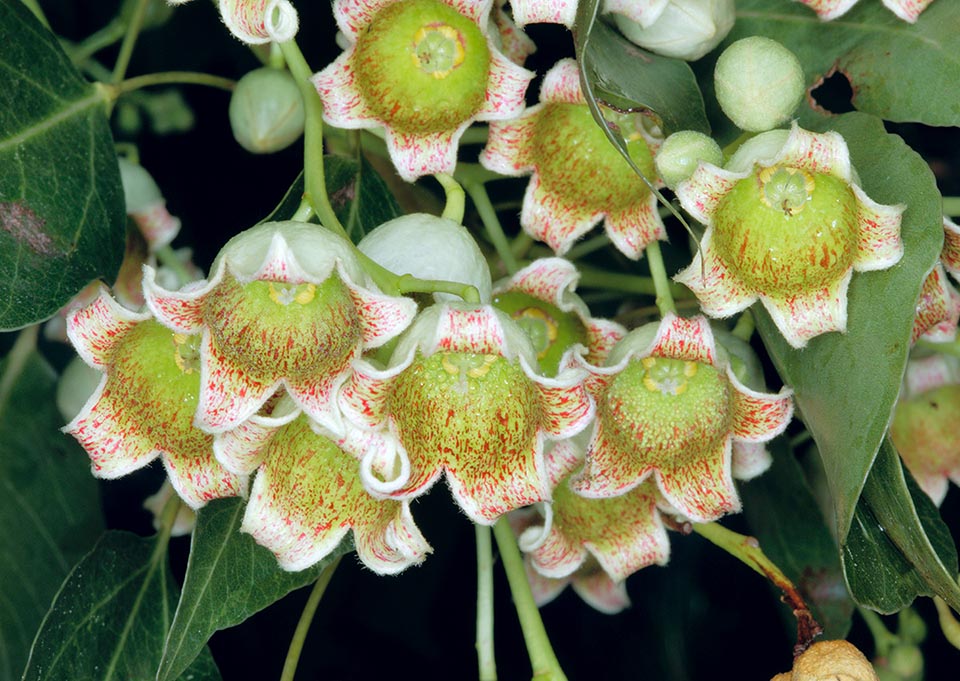
The flowers, merged in panicles, have no petals, with the typical shape of a bell of clear colour, dotted with red inside © Giuseppe Mazza
The roots of the young plants were used for their food. Moreover, in summer, the shepherds quenched the thirst of their sheep by making a hole in the trunk to extract the water and gave the leaves as fodder.
The seeds are rich in nutrients with about 18% of proteins, 25% of fats, besides high levels of zinc and magnesium. In the past they were consumed raw or roasted and appreciated also by the settlers who, after having milled and cleaned them from the fibres, used them to obtain a coffee substitute.
Due to its unique shape of the trunk and the attractive foliage, Brachychiton populneus is a species of medium growth, suitable for embellishing parks, gardens and streetscapes. Its wood is soft and spongy and in the past it was utilized to make shields.
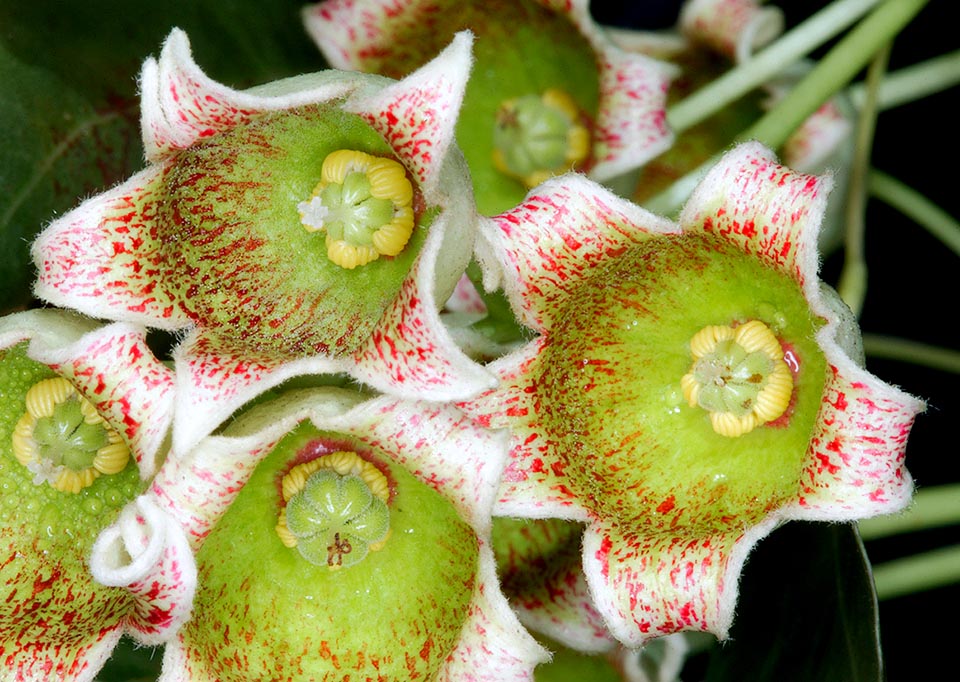
The female flowers have the stigmas merged at the base and the ovary surrounded by aborted stamens who don’t produce pollen called staminodes © Giuseppe Mazza
The propagation happens by cutting or by seeds. The germination is easier if the seeds are immersed in warm water and left to soak for the 12 following hours.
Thanks to the easy germination and to the beauty of its posture, this species has been introduced in south-western Australia, in southern Africa, In Louisiana, in California, in Arizona and along some coasts of the Mediterranean Sea.
The plant grows well in the sites where the annual day temperatures are between 25 and 32 °C, resists temperatures from 13 to 38 °C, but does not tolerate temperatures below zero.
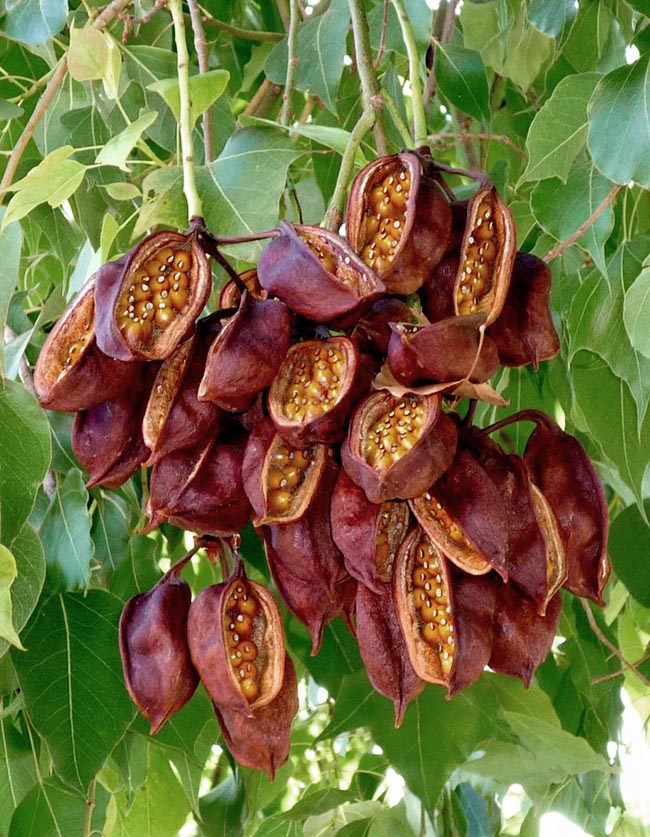
Open fruits with seeds. Similar to toy boats they stand on the branches for long time © Jesús Cabrera
It prefers an average annual rainfall included between 450 and 750 mm, but tolerates from 250 to 1000 mm on well drained moderately fertile soils, slightly acidic and in a sunny position.
It is subject to fungal infections, in particular on the wounds that have remained open after cuts.
It is also very susceptible to root rot in the soils rich in water with sudden darkening of the leaves and possible death.
Considering the dimensions of the trunk and of the crown the planting sites should be chosen carefully avoiding restricted spaces such as sidewalks or in the vicinity of homes. As a matter of fact, applying the method of the projection of the crown, a specimen of mature size (opening of the crown of 12 m) requires an area of about 113 square metres and a root volume of 68 cubic metres.
Brachychiton populneus is a species competitive with the spontaneous vegetation, therefore we need to pay attention to the planting locations, introduced by man, it is an invasive species, especially in the most disturbed natural areas.
Synonyms of Brachychiton populneus: Poecilodermis populnea Schott & Endl.
Synonyms of Brachychiton populneus subsp. populneus: Jatropha australis Lodd. ex G.Don; Brachychiton diversifolius var. muelleri A.Terracc.; Clompanus diversifolia (G.Don) Kuntze; Sterculia diversifolia G.Don; Sterculia diversifolia var. longipes Domin.
→ To appreciate the biodiversity within the MALVACEAE family please click here.
